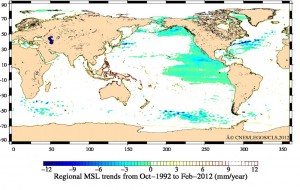OK, on one hand I am not surprised. The Sunday Mail is a paper I only ever read when it is being given away free.
The conversation in the shop this morning was
“Would you like a free paper, Peter?”
“What, the Sunday Mail?”
“Yes.”
“No thanks.”
“But it’s free.”
“Hmm…” (remembering I can use it as padding in parcels I send, and to start my fire in Winter) “OK then.”
Once I had it I could not resist leafing through it. Mostly just the usual empty-headed waffle that passes for journalism amongst the educated. A photo of Ian Thorpe emerging from a pool with a bit of mucous hanging from his nose, with the headline “Snot a good look.” That sort of thing.
On page 26 is an article by Lainie Anderson. It is available online.
Lainie seems a nice enough young lady. She has all the currently popular opinions. But she suffers from that curious left-wing journalist’s affliction of being unable to think.
This is the (very small) headline: Doesn’t it make sense to invest now in renewable technology – like the windfarms Denmark has established – and have something else to offer the world when the coal runs out?
Surely before writing that, or after for that matter, a journalist would stop to ask two key questions:
1. Are fossil energy sources running out?
2. Do wind-farms and other renewable energy technologies actually save any fossil fuel over their lifetimes?
The answer to both questions is no. Neither question seems to occur to Lainie.
A really good journalist might go on to consider the relationship between the price of energy and employment rates, and between the price of energy and poverty levels, and write about the possible development of a long term energy policy which would encourage economic growth, noting that this will be better for the planet, because wealthier societies have more liberty to be concerned about conservation.
But this is the Sunday Mail. So we have to read about Ian Thorpe and snot instead.
Lainie says that climate sceptics are just confusing people. They should stop it, because “we’ve got around 97 per cent of the world’s climate scientists telling us that human behaviour is warming the planet.”
Really?
Actually, no.
That figure is passed around like a hanky in a party game. It is based on a single study, Doran, P. T., and M. Kendall Zimmerman (2009), Examining the Scientific Consensus on Climate Change, Eos Trans. AGU, 90(3).
Doran and Zimmerman sent two questions to some 10,000 scientists. About 30% responded. According to Doran and Zimmerman, only 5% of respondents were climate scientists. Climate scientists are people who were authors for the IPCC, or other climate alarmist bodies. The answers given by this carefully selected group were used to arrive at the 97% figure quoted by Ms Anderson. According to the study, 76 of 79 answered ‘Yes’ to question 1, and 75 of 77 answered ‘Yes’ to question 2. That’s about 97%.
Already this is so dubious it smells like five day old road-kill. But what were the questions?
1. When compared with pre-1800s levels, do you think that mean global temperatures have generally risen, fallen, or remained relatively constant?
2. Do you think human activity is a significant contributing factor in changing mean global temperatures?
Virtually every ‘sceptic’ I know would answer ‘Yes’ to question one. The world has been warming at a pretty constant rate since about 1850. If CO2 is a factor in this increase, it can only have been a factor since about 1940. But there has been no change in the average rate of temperature increase since then.
Question 2 is simply badly written. What counts as significant? If there is a human influence on global climate change, it is so small compared with natural change that it is barely discernible. But that small amount may still be significant in some contexts.
So out of a group of 3,000 scientists, 97% of a very small and carefully selected sub group answered ‘Yes’ to two ambiguous questions, at least one of which would get a yes from almost every sceptical scientist. This is not proof of anything except a depressingly poor level of study design.
Lainie’s other ‘gotcha’ claims are that the world has been getting warmer for a while now, and that sea levels are rising. Both of these claims are true. No one disagrees. We have been coming out of a little Ice Age. Thank God it is getting warmer. Sea levels have been rising for the past 10,000 years, and if anything, the rate of rise is slowing.
No one denies that global climate is changing. It always has and always will.
The real question is, is there any evidence of damaging human influence on global climate? To answer that with a yes, there would have to be a clear correlation between human activity and global climate change. There is no correlation.
Climate alarmism may still sell a few papers. But it is damaging and dishonest. Just stop it.





